20.2 Absolute Advantage Intra-Industry Trade Between Similar Economies and Reducing the Barriers to International Trade
1/8
There's no tags or description
Looks like no tags are added yet.
Name | Mastery | Learn | Test | Matching | Spaced |
|---|
No study sessions yet.
9 Terms
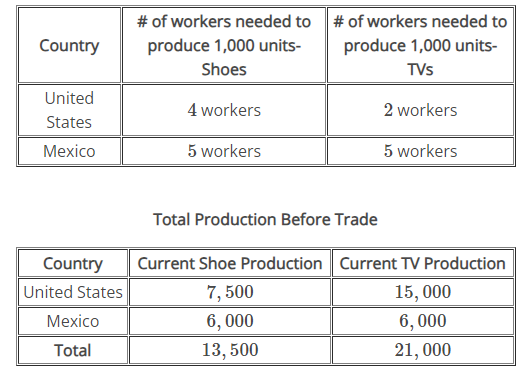
Consider the example of trade between the United States and Mexico described in the tables below.
Suppose that each country currently has 60 workers and each decides to transfer some amount of labor toward its area of comparative advantage. The United States transfers 12 workers away from shoes toward producing TVs. Mexico transfers 20 workers away from TVs toward producing shoes.
What will be the new total output of shoes for both countries combined?
14500
In this scenario, we can see that the United States has an absolute advantage in both goods and a comparative advantage in TVs. Mexico has a comparative advantage in shoes. Each country will specialize in producing where they have a comparative advantage by diverting labor toward the production of that good.
For the United States:
U.S. production of shoes decreases by 3,000 units (124×1,000), while U.S. production of TVs increases by 6,000 (122×1,000) units.
For Mexico:
Mexico’s production of TVs falls by 4,000 units (205×1,000), while Mexico’s production of shoes increases by 4,000 units (205×1,000).
Thus, once the two countries shift production toward comparative advantage, total output increases for both goods. The total output of shoes for both countries combined is 14,500.

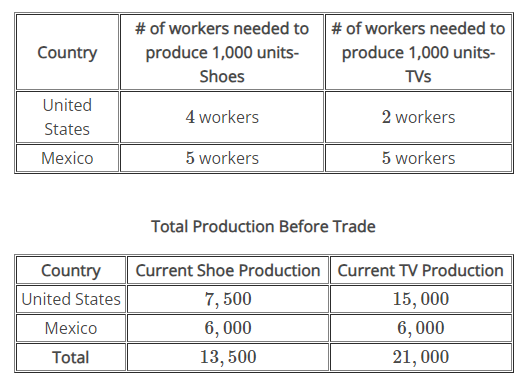
Suppose that each country currently has 60 workers and each decides to transfer some amount of labor toward its area of comparative advantage. The United States transfers 12 workers away from shoes toward producing TVs. Mexico transfers 20 workers away from TVs toward producing shoes.
What will be the new total output of TVs for both countries combined?
23000
In this scenario, we can see that the United States has an absolute advantage in both goods and a comparative advantage in TVs. Mexico has a comparative advantage in shoes. Each country will specialize in producing where they have a comparative advantage by diverting labor toward the production of that good.
For the United States:
U.S. production of shoes decreases by 3,000 units (124×1,000), while U.S. production of TVs increases by 6,000 (122×1,000) units.
For Mexico:
Mexico’s production of TVs falls by 4,000 units (205×1,000), while Mexico’s production of shoes increases by 4,000 units (205×1,000).
Thus, once the two countries shift production toward comparative advantage, total output increases for both goods. The total output of TVs for both countries combined is 23,000.
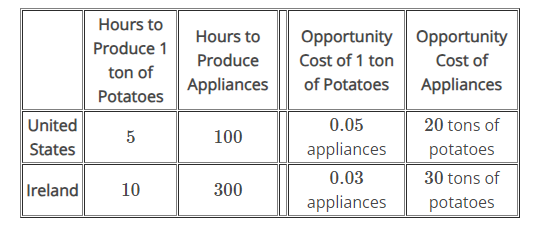
The United States and Ireland both produce potatoes and appliances. The table below describes the production capabilities of both countries.
The graph below shows the production possibilities frontier for the United States and Ireland. Suppose that the countries completely specialize in the production of the good for which they have a comparative advantage, the United States only produces appliances and Ireland only produces potatoes.
On the graph below, illustrate the consumption of the United States and Ireland if the U.S. exports 160 appliances to Ireland in exchange for Ireland exporting 4,000 tons of potatoes to the United States.
The “U.S. Consumption” point and the “Ireland Consumption” point are misplaced. Relocate the points to reflect the consumption bundles after trade for both countries.
The United States will consume 4,000 tons of potatoes and 440 appliances (4000,440) and Ireland will consume 2,000 tons of potatoes and 160 appliances (2000,160).
Since the United States has the comparative advantage in the production of appliances, they will produce 600 units of appliances and no potatoes. Ireland has the comparative advantage in the production of potatoes, they will produce 6,000 tons of potatoes and no appliances.
The terms of trade will be 4,000 tons of potatoes for 160 appliances. The U.S. will export appliances and import potatoes, while Ireland will export potatoes and import appliances. The table below shows how the consumption bundle is determined.
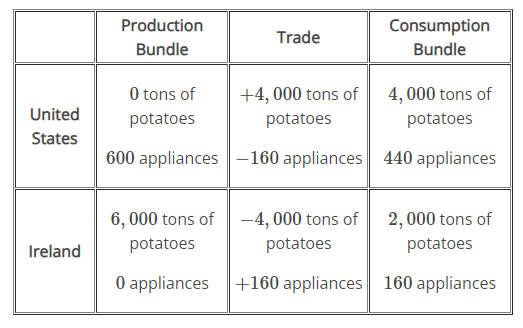
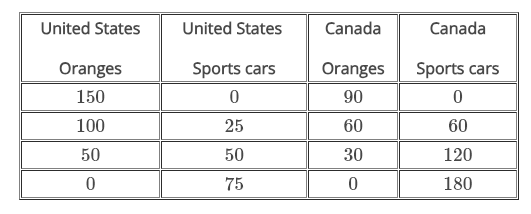
Assume a simple model with only two countries: the United States and Canada, and two goods: sports cars and oranges. The table below shows combinations of goods that each country could produce using all of its resources. Which nation would benefit from specializing in the production of sports cars and trading sports cars for oranges with the other nation?Select the correct answer below:
Canada
United States
neither nation, since neither has a comparative advantage in sports cars
both nations, since both have a comparative advantage in sports cars
Canada
For Canada, the opportunity of producing 1 sports car is 0.5 unit of oranges. For the United States, the opportunity cost of producing 1 sports car is 2 units of oranges. Since Canada's opportunity cost is lower, it has a comparative advantage in sports cars. As a result, Canada would benefit from specializing in the production sports cars and trading for oranges instead of focusing completely on domestic consumption.
Intra-industry trade allows companies to enjoy economies of scale because _____________________.
Select the correct answer below:
companies can expand production internationally, sell more units of output and lower per unit costs
companies can contain costs by learning from companies in other countries
companies can reduce costs by allowing more competition from abroad in the same industry
as the scale of output goes up, average costs of production increase
companies can expand production internationally, sell more units of output and lower per unit costs
The concept of economies of scale means that as the scale of output goes up, average costs of production decline. It becomes especially relevant to international trade when it enables one or two large producers to supply the entire country. Little or no competition will exist between different producers. International trade provides a way to combine the lower average production costs that come from economies of scale and still have competition and variety for consumers.
The World Trade Organization (WTO) has a main goal of
Select the correct answer below:
reducing the volume of international trade
lowering trade barriers
negotiating political agreements
all of the above.
lowering trade barriers
The World Trade Organization (WTO) is committed to lowering barriers to trade. The world’s nations meet through the WTO to negotiate how they can reduce barriers to trade, such as tariffs. WTO negotiations happen in “rounds,” where all countries negotiate one agreement to encourage trade, take a year or two off, and then start negotiating a new agreement.
Why do both nations benefit from trade in a situation where one nation has an absolute advantage in both goods?
Select the correct answer below:
The nation with absolute advantage, through trade, is able to move down its Production Possibility Frontier.
Both nations are able to move freely along their Production Possibility Frontiers.
Both nations, through specialization and trade, can move their economies to points outside of their current Production Possibility Frontiers.
Resources in each country are unlimited.
Both nations, through specialization and trade, can move their economies to points outside of their current Production Possibility Frontiers.
Resources are limited. Even though one nation has an absolute advantage in both goods it can be better off economically (move to a point outside of its current PPF) by specializing and trading. Trade allows each country to optimize the use of its resources and to take advantage of lower opportunity costs in the other country.
Intra-industry trade _________________ whenever only one or two large producers can supply the entire country.
Select the correct answer below:
leads to higher average costs of production
reduces total costs of production
provides a way for consumers to enjoy a variety of products
allows firms to expand their monopoly positions abroad
provides a way for consumers to enjoy a variety of products
The concept of economies of scale means that as the scale of output goes up, average costs of production decline. It becomes especially relevant to international trade when it enables one or two large producers to supply the entire country. International trade provides a way to combine the lower average production costs that come from economies of scale and still have competition and variety for consumers.
Firms and workers who specialize in a certain product become more productive with learning and practice. This is an example of how
Select the correct answer below:
specialization leads to narrowing of skills of workers
division of labor could increase output
countries become less able to participate in intra-industry trade
production costs rise
division of labor could increase output
The division of labor could increase output for three reasons: (1) workers with different characteristics can specialize in the types of production where they have a comparative advantage; (2) firms and workers who specialize in a certain product become more productive with learning and practice; and (3) economies of scale. These three reasons apply from the individual and community level right up to the international level.